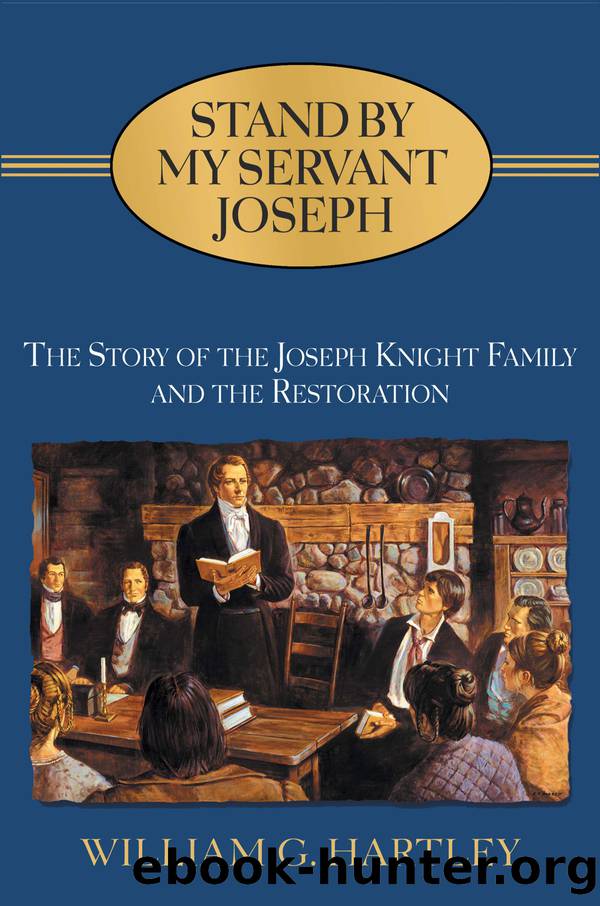Stand By My Servant Joseph: Story of the Joseph Knight Family by William G. Hartley

Author:William G. Hartley [Hartley, William G.]
Language: eng
Format: epub
Tags: Church History, Church of Jesus Christ of Latter-day Saints, Mormon
ISBN: 1609085949
Publisher: Deseret Book Company
Published: 2003-08-15T00:00:00+00:00
CAUSES OF DIVISION
On March 14, 1838, Joseph Smith arrived at Far West from Kirtland.24 Spring was still a month away. Matted, stiff, dry prairie grasses slumped a lifeless yellow, and bare tree limbs wafted like skeletons in afternoon breezes. The landscape was late winter-gray and so was the Prophet's situation. Unlike his prior, short visits to monitor Church matters in Missouri, this time he came to stay, having escaped from Ohio. He made Far West the new headquarters for the Church. Difficulties had so plagued Church operations in Kirtland that he told believers there to sell out and move to Caldwell County. Joseph and Emma, who was six months pregnant, became Far West residents. Like other Missouri Saints, the Knight relatives were delighted to have their friend and leader live among them but disappointed by the Kirtland setbacks and the Church's abandonment of the cherished temple.
As Joseph Smith explained then and historians have elaborated since, once the Kirtland Temple was dedicated, Joseph Smith began to promote âan important shift in emphasis and priority,â one that tested the loyalty of his followers. At issue was his effort to involve the Church in Kirtland's economy. His hope was to create a gathered community that acted in all aspects under priesthood directionâa merging of the temporal and the spiritual. Joseph was seeking to establish a preparatory theocratic government to turn over to Christ when he came to reign on earth. This âkingdom idealâ challenged many, including some of the Twelve, who felt a prophet had no business directing their temporal lives. Oliver Cowdery was one who thought the people should be left alone to attend to temporal affairs without interference from Church leaders. With Joseph's guidance, Church involvements in Kirtland economic decisions and institutions âincreased considerablyâ during 1837 and 1838.25
A Church-operated bank became a key point of contention. After the Kirtland Temple was dedicated early in 1836, Church leaders tried to provide more places in Kirtland for Saints to live and work. They bought a lot of property on credit. Then, facing rapidly inflating land prices and an increase in business transactions, they established a bank. When the state refused to charter the bank, its founders and stockholders operated it as the Kirtland Safety Society Anti-Banking Companyâa non-bank providing banking services. Such pseudo-banking, while marginal, was fairly widespread in the Midwest. The First Presidency promoted the bank and urged members to buy stock in it and be bank customers. The bank sold stock, invested, and made loans.26
Unfortunately, robust regional and national economic conditions suddenly weakened, sending the nation precipitously into the national depression of 1837. Although chartered banks in Ohio survived, most of the unchartered ones, including the Kirtland bank, failed. Debtors could not pay back loans, causing about two hundred investors in the Kirtland bank to lose almost all they had subscribed. The bank's paper currency became worthless. The Church found it could not pay off its indebtedness. This bank failure hurt many and caused many to doubt that Joseph Smith was any kind of revelator.
Download
This site does not store any files on its server. We only index and link to content provided by other sites. Please contact the content providers to delete copyright contents if any and email us, we'll remove relevant links or contents immediately.
| Military | Political |
| Presidents & Heads of State | Religious |
| Rich & Famous | Royalty |
| Social Activists |
Waking Up in Heaven: A True Story of Brokenness, Heaven, and Life Again by McVea Crystal & Tresniowski Alex(37040)
Empire of the Sikhs by Patwant Singh(22208)
We're Going to Need More Wine by Gabrielle Union(18112)
Hans Sturm: A Soldier's Odyssey on the Eastern Front by Gordon Williamson(17044)
Leonardo da Vinci by Walter Isaacson(11955)
The Radium Girls by Kate Moore(10947)
Educated by Tara Westover(7096)
Tools of Titans by Timothy Ferriss(7004)
How to Be a Bawse: A Guide to Conquering Life by Lilly Singh(6727)
The Last Black Unicorn by Tiffany Haddish(5095)
Permanent Record by Edward Snowden(5035)
The Rise and Fall of Senator Joe McCarthy by James Cross Giblin(4859)
Promise Me, Dad by Joe Biden(4480)
The Wind in My Hair by Masih Alinejad(4441)
The Crown by Robert Lacey(4127)
A Higher Loyalty: Truth, Lies, and Leadership by James Comey(4061)
The Iron Duke by The Iron Duke(3666)
Joan of Arc by Mary Gordon(3282)
How to be Champion: My Autobiography by Sarah Millican(3202)
